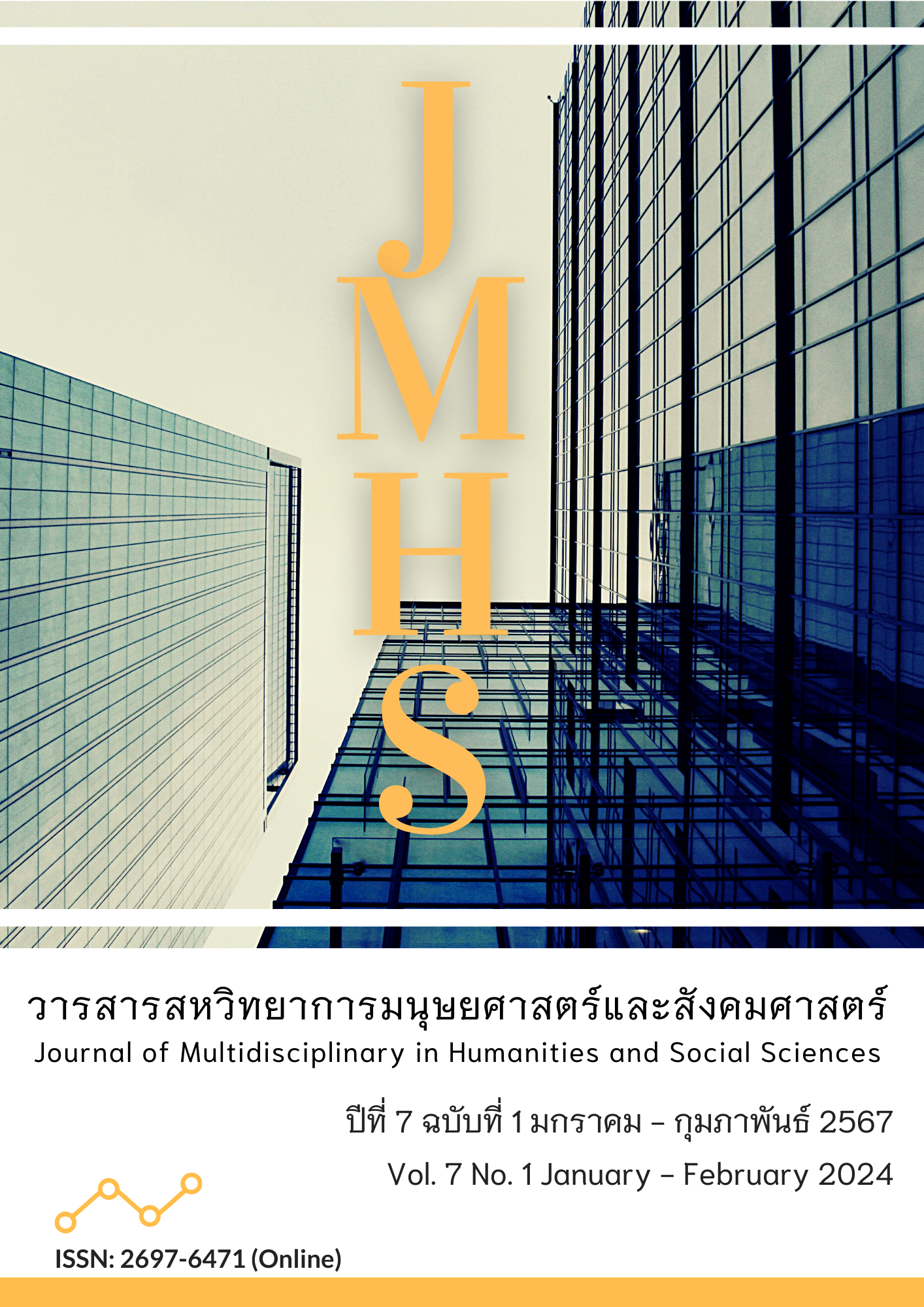Model of Sufficient Financial Management to Prepare for Retirement of Educational Personnel: Case Study of Private Universities in Bangkok and Metropolitan Area
Main Article Content
Abstract
The article aimed to 1) to study causal factors influencing adequate financial management styles to prepare educational personnel for retirement; Case Study of Private Universities in Bangkok and Metropolitan Area and 2) To study the model of preparation for retirement of educational personnel; Case Study of Private Universities in Bangkok and Metropolitan Area. The research is a mixed methods research by quantitative research The instrument used was a questionnaire. The sample group was educational personnel at higher education institutions and private universities. In Bangkok and surrounding areas, 300 cases, qualitative research the tool used was an interview form. The sample group was educational personnel aged 40 years and over, 10 persons. The Statistics used in data analysis include percentage, mean, standard deviation. and analysis of structural equation models using statistical tools Structural Equation Modeling (SEM).
The results of this research were the development of the causal relationship models of 1) financial knowledge 2) investment style and 3) retirement planning Consistent with empirical data The financial knowledge factor has a direct influence on retirement planning, equal to 0.692. It has both a direct and indirect influence on readiness to enter retirement age, equal to 0.663. Investment style has a direct influence on retirement planning, equal to 0.055. Both direct and indirect influence on readiness to enter retirement age is equal to 0.176 and retirement planning has a direct influence on readiness to enter retirement age equal to 0.412 for the model of preparation for retirement age of educational personnel. A case study of private universities in Bangkok and surrounding areas found that they mainly consisted of financial knowledge factors. Next is retirement planning and investment style.
Article Details

This work is licensed under a Creative Commons Attribution-NonCommercial-NoDerivatives 4.0 International License.
Views and opinions appearing in the Journal it is the responsibility of the author of the article, and does not constitute the view and responsibility of the editorial team.
References
กรมกิจการผู้สูงอายุ, กระทรวงการพัฒนาสังคมและความมั่นคงของมนุษย์ (พม.). (2565). สถิติผู้สูงอายุของประเทศไทย 77 จังหวัด ณ.วันที่ 31 ธันวาคม 2565. สืบค้นจาก https://www.dop.go.th/th/know/side/1/1/1766
กาญจนา หงส์ทอง. (2551). เข็มทิศการเงิน. กรุงเทพฯ: กรุงเทพธุรกิจ.
เข็มเพขร เจริญรัตน์ และคณะ. (2550). การเงินธุรกิจ. กรุงเทพฯ: มหาวิทยาลัยธุรกิจบัณฑิตย์.
ธนาคารแห่งประเทศไทย. (2556). รายงานผลการสำรวจทักษะทางการเงินของไทย ปี 2556. สืบค้นจาก https://www.bot.or.th/content/dam/bot/image/research-and-publications/2556ThaiFLsurvey.pdf
บรรลุ ศิริพานิช. (2550). คู่มือผู้สูงอายุ: ฉบับเตรียมตัวก่อนสูงอายุ (เตรียมตัวก่อนเกษียณการงาน). กรุงเทพฯ: หมอชาวบ้าน
ประชา บุญมา และ วิชิต อู่อัน. (2564). ปัจจัยเชิงสาเหตุที่มีอิทธิพลต่อการวางแผนเกษียณอายุของพนักงานบริษัทเอกชนในประเทศไทย. วารสารวิชาการมหาวิทยาลัยธนบุรี, 16(2), 171-183. สืบค้นจาก https://so03.tci-thaijo.org/index.php/trujournal/article/view/252596
พรรณุภา ธุวนิมิตรกุล (2553). การเงินธุรกิจ. (พิมพ์ครั้งที่ 5). กรุงเทพฯ: มหาวิทยาลัยธรรมศาสตร์.
มนสิการ กาญจนะจิตรา, สุภรต์ จรัสสิทธิ, และ ชื่นฤทัย กาญจนะจิตรา. (2555). เกษียณเมื่อไหร่ ให้ใครกำหนด. นครปฐม: สถาบันวิจัยประชากรและสังคม มหาวิทยาลัยมหิดล.
มูลนิธิสถาบันวิจัยและพัฒนาผู้สูงอายุไทย. (2561, 7 ธันวาคม). รายงานสถานการณ์ผู้สูงอายุไทย พ.ศ. 2560. สืบค้นจาก https://thaitgri.org/?p=38607
ประกาศสำนักทะเบียนกลาง เรื่อง จำนวนราษฎรทั่วราชอาณาจักร ตามหลักฐานการทะเบียนราษฎร. (2565, 18 มกราคม). ราชกิจจานุเบกษา. เล่ม 139, ตอนพิเศษ 12ง, หน้า 10. สืบค้นจาก https://www.ratchakitcha.soc.go.th/DATA/PDF/2565/E/012/T_0010.PDF
Bodie, Z., Treussard, J., & Willen, P. (2007). The Theory of Life-Cycle Saving and Investing. FRB of Boston Public Policy Discussion Paper N. 07-3. Retrieved from http://dx.doi.org/10.2139/ssrn.1002388
Chaffin, C.R. (2013). The Financial Planning Competency Handbook. Canada: John Wiley & Sons.
Coile, C.C. (2015). Economic Determinants of Workers’ Retirement Decisions. Journal Economic Surveys, 29(4), 830-853. https://doi.org/10.1111/joes.12115
Davis, G. D., & Chen, Y. (2008). Age Differences in Demographic Predictors of Retirement Investment Decisions. Educational Gerontology, 34(3), 225-246. https://doi.org/10.1080/03601270701838365
Diamantopoulos, A., & Siguaw, J. A. (2000). Introducing LISREL. London: Sage. https://doi.org/10.4135/9781849209359
Garman, E.T., & Forgue, R. (2011). Personal Finance. (11th ed.). Cengage Learning.
Hair, J., Anderson, R., Tatham, R. and Black, W. (1998). Multivariate Data Analysis. (5th ed.). New Jersey: Prentice Hall.
Harrison-Walker, L. J. (2001). The Measurement of Word-of-Mouth Communication and an Investigation of Service Quality and Customer Commitment as Potential Antecedents. Journal of Service Research, 4(1), 60–75. https://doi.org/10.1177/109467050141006
Kapoor, J. R., Dlabay, L. R., & Hughes, R. J. (2009). Personal Finance. (9th ed). McGraw-Hill.
Leedy, J.J., & Wynbrandt, J. (1987). Executive Retirement Management: A Manager's Guide to the Planning and Implementation of a Successful Retirement. Hardcover.
Lusardi, A., & Mitchell, O.S. (2006). Financial Literacy and Planning: Implication for Retirement Wellbeing. Pension Research Council, The Wharton School, University of Pennsylvania.
Mithcell, O., & Utkus, S.P. (2006). How Behavioral Finance Can Inform Retirement Plan Design1. Journal of Applied Corporate Finance, 18(1), 82-94. DOI: 10.1111/j.1745-6622.2006.00076.x
Mokaya, K.N., & Maina, K. (2017). Financial Factors Affecting Retirement Planning by Savings and Credit Cooperative Employees in Nakuru Town, Kenya. The International Journal of Business & Business & Management, 5(10). Retrieved from https://www.internationaljournalcorner.com/index.php/theijbm/article/view/125423
OECD. (2014). Education at a Glance 2014: OECD Indicators. OECD Publishing. Retrieved from http://dx.doi.org/10.1787/eag-2014-en
Papalia, D.E., & Olds, S. W. (1995). Human Development. (6th ed.). New York: McGraw-Hill.
Selvadurai, V., Kenayathulla, H.B., & Siraj, S. (2018). Financial Literacy Education and Retirement Planning in Malaysia. Malaysian Online Journal of Educational Management (MOJEM), 6(2), 41-66. https://doi.org/10.22452/mojem.vol6no2.3
Tapia, W., & Yermo, J. (2007). Implications of Behavioural Economics for Mandatory Individual Account Pension Systems. SSRN Electronic Journal. DOI:10.2139/ssrn.1217604


